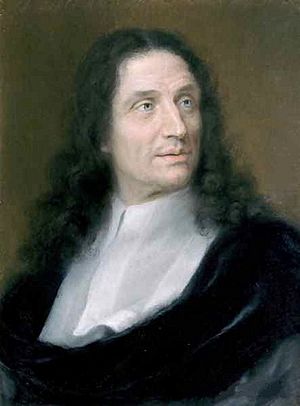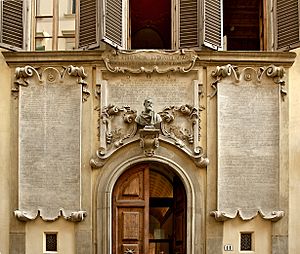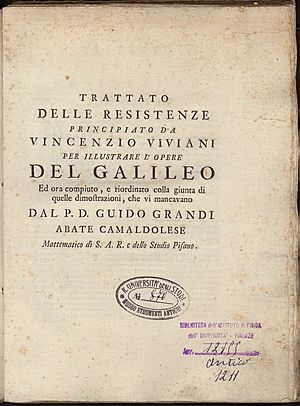Vincenzo Viviani facts for kids
Quick facts for kids
Vincenzo Viviani
|
|
|---|---|

Vincenzo Viviani
|
|
| Born | April 5, 1622 |
| Died | September 22, 1703 (aged 81) Florence, Grand Duchy of Tuscany
|
| Nationality | Tuscan |
| Known for | Viviani's theorem Viviani's curve |
| Scientific career | |
| Fields | Mathematician and physicist |
| Academic advisors | Galileo Galilei Evangelista Torricelli |
| Notable students | Isaac Barrow |
Vincenzo Viviani (born April 5, 1622 – died September 22, 1703) was an important Italian mathematician and scientist. He was a student of Torricelli and a close helper of Galileo. Viviani helped preserve Galileo's work and made his own discoveries in mathematics and physics.
Contents
Early Life and Learning
Vincenzo Viviani was born in Florence, Italy. His parents were Jacopo di Michelangelo Viviani and Maria Alamanno del Nente. He went to a Jesuit school where he studied the humanities.
After that, Viviani became very interested in mathematics. He learned geometry from Clemente Settimi, who was a follower of Galileo. Through Clemente, Viviani met Famiano Michelini, a mathematician at the Tuscan Court.
Working with Galileo
In 1638, Michelini told Grand Duke Ferdinand II de’ Medici about Viviani's talents. The Grand Duke was impressed and offered Viviani money to continue his studies. He also introduced Viviani to Galileo Galilei.
Galileo was getting older and needed a skilled assistant. Viviani moved to Galileo's home in Arcetri in 1639. He helped Galileo with his studies, including the book Two New Sciences. In this book, Galileo studied how objects speed up when they fall or roll down a slope.
Viviani learned a lot about the philosophy of nature from Galileo. Their discussions helped Galileo finish his ideas about how objects fall. Viviani was Galileo's last student before Galileo passed away in 1642.
In 1641, Evangelista Torricelli joined them. Viviani also became a student of Torricelli and worked on physics and geometry with him.
After His Teachers
After Torricelli died in 1647, Viviani took over his job at the Accademia dell'Arte del Disegno in Florence. A decade later, Viviani also became one of the first members of the Accademia del Cimento. This was an experimental academy started by the Grand Duke.
Keeping Galileo's Legacy Alive
Viviani spent much of his life making sure Galileo's work and life were remembered. In 1654, Cardinal Leopoldo de' Medici asked Viviani to collect information for a book about Galileo. Viviani also helped create a collection of Galileo's works.
From 1655 to 1656, Viviani edited the first collection of Galileo's writings. He tried to publish a story about Galileo's life. However, he said his efforts were stopped by the Catholic Church.
Studying Ancient Mathematics
One of Viviani's main interests was the mathematics of ancient times. He spent a lot of time working to bring back the writings of old mathematicians like Aristaeus the Elder and Apollonius.
Scientific Discoveries and Experiments
Measuring the Speed of Sound
In 1660, Viviani and Giovanni Alfonso Borelli did an experiment to find the speed of sound. They measured the time between seeing a cannon flash and hearing its sound from a distance. They calculated the speed to be 350 meters per second (m/s). This was much more accurate than earlier measurements. Today, we know the speed of sound is about 340.29 m/s at sea level.
Pendulum Observations
It is also said that in 1661, Viviani experimented with pendulums. He noticed that a pendulum would slowly move to one side as it swung. He didn't connect this to the Earth's rotation, which was discovered much later by Léon Foucault. Viviani simply fixed it by hanging the pendulum with two ropes.
Becoming a Court Mathematician
By 1666, Viviani was famous as a mathematician. He received many job offers. Louis XIV of France offered him a job at the Académie Royale. John II of Poland also offered him a position as his astronomer.
The Grand Duke, not wanting to lose Viviani, made him the First Mathematician of the Tuscan Court. This important job had been held by Galileo and then Torricelli. Viviani accepted this position and turned down the other offers.
From 1666 to 1667, Viviani also helped Nicolaus Steno. They worked on the geometry of anatomical shapes and how shark muscle fibers worked. Their work showed how geometry could explain the functions of body parts.
Later Works and Legacy
In 1687, Viviani published a book about engineering. It was called Discorso intorno al difendersi da' riempimenti e dalle corrosione de' fiumi.
When Viviani died, he left a book about the strength of solids almost finished. Luigi Guido Grandi completed and published it later.
In 1737, the Church allowed Galileo to be reburied in a special grave. Viviani had left money for this monument. Viviani's own remains were also moved to Galileo's new grave.
A crater on the Moon is named Viviani in his honor.
Inscriptions
In Florence, Viviani had Galileo's life and achievements written in Latin on the front of his palace. These writings were on huge stone scrolls. Because of this, the palace was renamed Palazzo dei Cartelloni.
Selected Works
- Racconto istorico della vita di Galileo Galilei (Historical Account of the Life of Galileo Galilei) (written in 1654, published in 1717).
- "Relazione intorno al riparare per quanto possibile sia la città e campagne di Pisa dall'inondazioni" (April 12, 1684).
See also
- Galileo's Leaning Tower of Pisa experiment
- Viviani's theorem
- Viviani's curve



